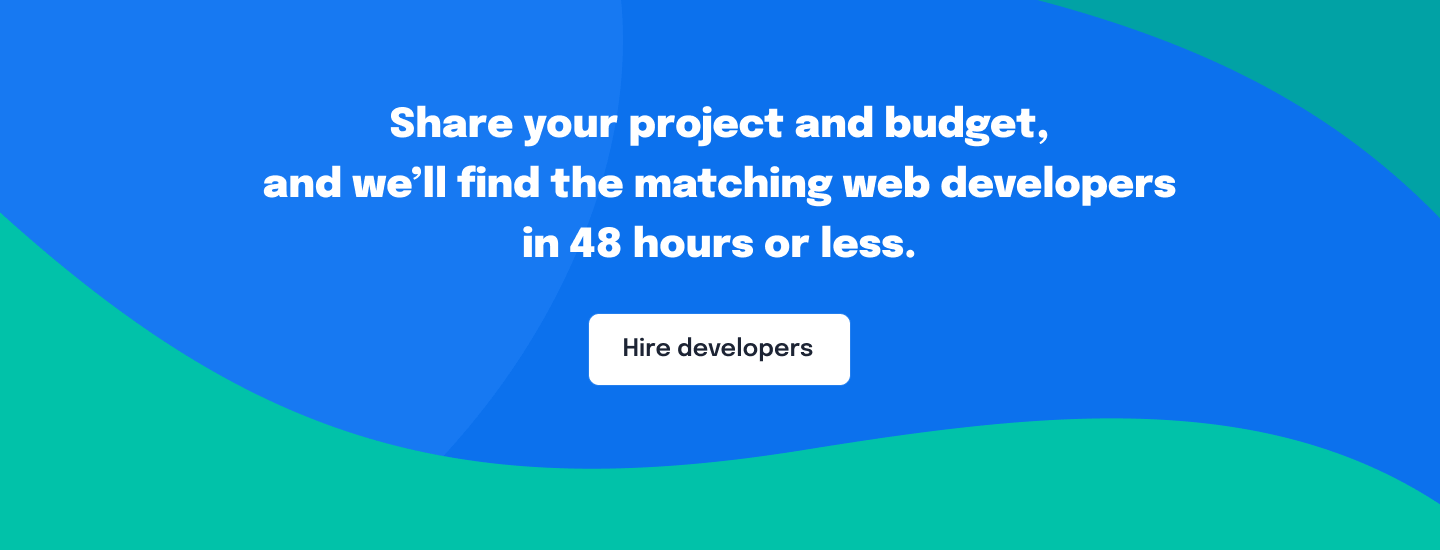Web Development is a vast and ever-changing field. Whether constructing an accessible website or a complex web app, staying updated with the latest technologies is essential. MDN Web Docs is an excellent resource for new people who need to learn the basics.
But let’s be honest, the right tools and frameworks can make your life easier. They give you a head start with prepared-to-use code snippets, libraries, and prebuilt features.
So, what is in this blog for you? We’re diving into popular front-end frameworks like React, Angular, Vue.js, and Svelte. And we’re not stopping there; we’ll also discuss backend frameworks and other required tools used in the dev world.
Table of Contents
Popular Front-end Frameworks for Web Development
React
What is React?
React is a JavaScript library for building user interfaces, particularly complex ones that require real-time updates. React was developed by one of Facebook’s software engineers and maintained by Facebook; it’s not a full-fledged framework but focuses mainly on the view layer in the MVC architecture. Facebook’s newsfeed first used it.
Why is React popular?
- Easy to Learn and Use: Has an easy learning curve compared to other front-end frameworks.
- Strong Community Support: Extensive community contributions mean a wealth of third-party libraries and tools.
- Virtual DOM: Optimizes rendering and improves performance, especially in large applications.
Use-cases of React
- Single Page Applications (SPA): React’s efficient update and render system makes it ideal for SPAs.
- Mobile Applications: With React Native, you can write mobile apps in React.
- Dynamic Web Applications: Suitable for real-time data handling and rendering projects.
Angular
What is Angular?
Angular is a platform and framework for building client-side applications. Angular was first developed by one of Google’s developers; it uses TypeScript and offers a complete toolkit for developing robust and scalable web applications.
Why is Angular popular?
- Two-way Data Binding: Simplifies the synchronization between the model and the view.
- Dependency Injection: Makes it easier to manage components and improves code reusability.
- Comprehensive Tooling: Provides many tools and libraries for testing, navigation, and UI components.
Use-cases of Angular
- Enterprise-level Applications: Its robustness and scalability make it suitable for large-scale development projects
- Angular is excellent for building real-time, dynamic web applications.
- Mobile Applications: Angular can also create mobile apps with frameworks like Ionic.
Vue.js
What is Vue.js?
Vue.js is a framework used to build user interfaces on HTML, CSS, and JavaScript. Unlike monolithic frameworks, Vue is designed to be incrementally adoptable, allowing you to integrate it into projects where JavaScript is already being used.
It makes the user interface more simple and easy.
Why is Vue.js popular?
- Easy Integration: This can be easily integrated with other libraries or existing projects.
- Reactive Data Binding: A simple and flexible API for reactive two-way data binding is offered.
- Straightforward Syntax: Its template syntax is simple, making it easier to write and understand the code.
Use-cases of Vue.js
- Single Page Applications (SPA): Vue’s reactivity and component-based architecture make it a good choice for SPAs.
- Vue.js is Suitable for projects that require complex, interactive UIs.
- Small to Medium-sized Projects: Its ease of integration makes it a good choice for smaller projects or adding more complex interactions to existing sites.
Svelte
What is Svelte?
Svelte is a radical new approach to building user interfaces. Unlike traditional frameworks like React and Angular, Svelte shifts much of the work from the browser to compile time, creating highly efficient code.
Why is Svelte popular?
- No Virtual DOM: Eliminates the need for a virtual DOM, resulting in faster updates and rendering.
- Simplified State Management: This makes handling component states easier without needing extra libraries.
- Faster Runtime Performance: The compile-time optimization results in faster runtime performance.
Use-cases of Svelte
- Web Applications Requiring Speed: Its efficiency makes it ideal for web apps where speed is crucial.
- Small to Medium-sized Projects: Its simplicity and ease of integration make it a good choice for smaller projects.
- Interactive Web Components: Ideal for building reusable, interactive web components without relying on a heavier framework.
Popular Backend Frameworks for Web Development
Laravel
What is Laravel?
Laravel is a PHP web application framework with syntax mainly for making web development tasks easier and faster. It offers a clean API and a robust set of tools and libraries, which makes it a popular choice for modern web developers. If you want to build a complex application, consider hiring a Laravel developer with specialized expertise.
Why is Laravel popular?
- Eloquent ORM: Provides an elegant way to interact with databases.
- Blade Templating Engine: Allows for easy embedding of PHP code in HTML files.
- Artisan Console: Offers a range of custom commands for everyday tasks.
Use-cases of Laravel
- API Development: Its built-in features, like API authentication, make it a strong choice for backend API development.
- E-commerce Platforms: The robust set of libraries and easy database migration make it ideal for e-commerce.
- Content Management Systems: If you’re looking to hire a Laravel developer, it’s often for CMS development due to the framework’s flexibility and ease of use.
Node.js
What is Node.js?
Node.js is a runtime environment that lets you execute JavaScript on the server. Node js is built on Chrome’s V8 JavaScript engine. It’s designed for building scalable network-side applications.
Why is Node.js popular?
- Using Non-blocking I/O: Allows handling of multiple operations simultaneously without waiting for one to complete.
- Event-driven Architecture: Makes it highly suitable for I/O-bound applications.
- Robust Package Ecosystem: The npm registry hosts many reusable modules.
Use-cases of Node.js
- Ideal for building real-time apps like chat applications, online gaming, and collaborative editing.
- They were often used to build RESTful APIs that can handle many simultaneous connections.
- Efficiently reads and writes data in chunks, making it suitable for video or audio streaming.
You can use the top Node.js frameworks to quickly develop creative and feature-rich web applications.
Django
What is Django?
Django is a high-level Python web framework encouraging rapid development and clean, pragmatic design.
Django is developed and maintained by the Django software foundation. It comes with some built-in features for ease of web development.
Why is Django popular?
- Built-in Admin Panel: Provides a ready-to-use admin framework that saves development time.
- Strong ORM: Allows for complex database queries without needing to write SQL.
- Rich Middleware Support: Offers various built-in middleware and the flexibility to write custom middleware.
Use-cases of Django
- Its admin panel and ORM make it ideal for CMS development.
- Built-in libraries for everyday tasks like authentication and form handling make it suitable for e-commerce.
- Its ability to handle complex data models and perform complex queries makes it worthwhile in scientific computing.
Ruby on Rails
What is Ruby on Rails?
Ruby on Rails, often just called Rails, is a web application framework written in Ruby. It follows the Model-View-Controller (MVC) architectural pattern and emphasizes Convention over Configuration (CoC) and Don’t Repeat Yourself (DRY).
Why is Ruby on Rails popular?
- Convention over Configuration: Reduces the number of decisions a developer has to make.
- DRY Principle: Encourages code reusability and maintainability.
- Strong Community: A large and active community contributes to a rich ecosystem of libraries, or “gems.”
Use-cases of Ruby Rails for Web development
- Its rapid development capabilities make it ideal for feature-rich social platforms.
- Built-in features like inventory management and payment gateway integration make it suitable for e-commerce.
- Its modular approach makes it easy to build and maintain CMS platforms.
Spring Boot
What is Spring Boot?
Spring Boot is an extension of the Spring framework designed to simplify the bootstrapping and development of new Spring applications. It takes an opinionated view of the Spring platform to enable a quick and easy setup.
Why is Spring Boot popular?
- Auto-configuration: Automatically configures your application based on the libraries you have in your project.
- Standalone Applications: You can build standalone, production-grade applications with embedded servers.
- Wide Range of Extensions: Offers many additional features and functionalities through extensions.
Use-cases of Spring boot
- Its ease of setup and scalability make it ideal for developing microservices.
- Spring boot’s robustness and wide range of features make it suitable for large-scale applications.
- Built-in support for creating RESTful services makes it a go-to for API development.
Other Essential Tools for Web Development
Git
What is Git?
Git is a distributed version control system that handles everything from small to massive projects quickly and efficiently. It allows multiple people to work on the same project simultaneously.
Why is Git essential?
- Collaboration: Enables multiple developers to work on the same project without interfering with each other.
- Versioning: Keeps a history of all changes, allowing you to revert to previous code versions.
- Branching and Merging: You can create branches to work on separate tasks and merge them into the main codebase.
Use-cases of Git
- Git is often the go-to for open-source because it allows for collaborative work.
- In a team setting, Git allows for features like branching and merging, making integrating code from multiple team members easier.
- If a bug is discovered, Git allows you to roll back to previous stable versions of your code. It also facilitates code reviews by tracking changes and who made them.
Docker
What is Docker?
The Docker platform uses OS-level virtualization to package and run applications in containers. We can build, test, and deploy applications faster. These containers can include all the dependencies an application needs to run.
Why is Docker essential?
- Ensures the application runs the same way everywhere, Docker eliminating the “it works on my machine” problem.
- Quickly scale applications up or down, both manually and automatically.
- Containers are isolated, making it easier to manage dependencies and avoid conflicts.
Use-cases of Docker
- Docker is ideal for microservices architecture, where each service can run in its container to avoid conflict.
- Automate the build, test, and deployment phases of your application.
- Application Deployment: Package your application and its dependencies into a single container for easy deployment and scaling.
Webpack
What is Webpack?
Webpack is a module bundler for JavaScript applications. It takes the code from your application and turns it into something easier to deploy, often a single JavaScript file.
Why is Webpack essential?
- Code Splitting: You can split your code into various bundles, which can be loaded on demand or in parallel.
- Tree Shaking: Eliminates dead code from your final bundle, making it lighter.
- Hot Module Replacement (HMR): Enables real-time updates without refreshing the page, improving development speed.
Use-cases of Webpack
- Helps manage complexities by bundling various assets and modules.
- Efficiently loads the necessary code for different parts of an SPA.
- Webpack can be configured differently for development and production, optimizing performance.
ESLint
What is ESLint?
ESLint is a static code analysis tool for identifying problematic patterns in JavaScript code. It doesn’t just find issues; it also fixes them automatically where possible.
Why is ESLint essential?
- Code Quality: Helps maintain a high code standard by quickly catching errors and code smells.
- Maintainability: Makes it easier for teams to read and understand the code, reducing the cost of future changes.
- Adherence to Coding Standards: Ensures your code follows style guidelines and best practices.
Use-cases of ESlint
- It can be integrated into your code review process to flag issues automatically.
- Use ESLint to the city when merging automatically into the main branch.
- Great for learning JavaScript best practices and enforcing them on your project.
Conclusion
This article overviews popular frameworks and tools used in web development today. We discussed popular front-end frameworks like React, Angular, Vue.js, and Svelte. This helps developers build the user interface and visual elements of a website.
For the backend, we talked about Node.js, Django, Ruby on Rails, and Spring Boot. These frameworks help with behind-the-scenes functions like integrating with databases. It also highlights essential development tools, including Git, Docker, Webpack, and ESLint. These assist with workflows and processes in web development.
The main takeaway is that many options exist for frameworks and tools. Developers should try different ones to find the best for their project. Hands-on experimentation is critical for learning.
These articles encourage developers to start building things and keep learning. This will allow them to make better websites and applications moving forward. It motivates continued growth through active coding and practice.
FAQs on Popular Web Development Frameworks and Tools
What is a web development framework?
How do I choose a web development framework?
Choosing a web development framework depends on several factors:
- Project requirements
- Language preference
- Community support
- Learning curve
Are web development tools necessary?
What are some emerging web development frameworks?
Emerging frameworks to keep an eye on include:
- Blazor for WebAssembly-based apps
- FastAPI for high-performance APIs
- RedwoodJS for JAMstack architecture
ou can learn about emerging technologies from various online resources, including Django’s official website for Python-based frameworks.






